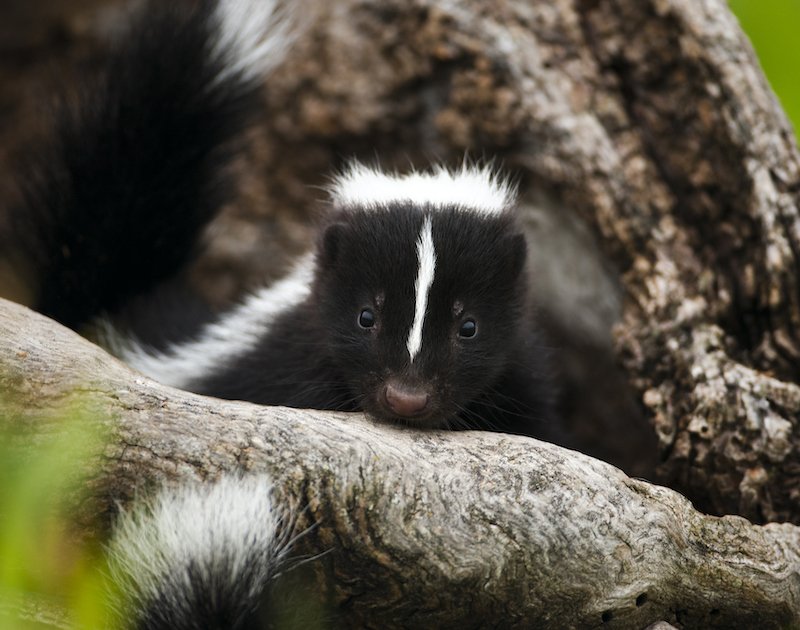A Stinky Tale
Created Creature
by Buddy Davis on July 1, 2023
Hey Kids, I’m Buddy Davis, a singer, songwriter, adventurer, and the host of Amazing Adventures on Answers TV.
Ring, ring! I picked up my phone. “Hello?”
“Buddy, this is Uncle Larry.” (He’s really my cousin, but I always call him “uncle.”) “I’m in a pickle,” he said.
“How can I help?”
“You may not want to,” Larry replied. “I set a live box trap by the garage to catch a groundhog, and guess what I caught?”
“What?” I asked.
“A skunk! I was hoping you would know how to release it without making it release its smell.” Larry chuckled.
Have you heard the latest joke about skunks? Never mind, it stinks.
When I got to Larry’s house, I saw that, sure enough, he’d caught a beautiful skunk with two white stripes down its back. The skunk didn’t look too stressed. That was a good thing. A scared skunk sprays a stinky smell!
Uncle Larry brought me an old blanket, and, using a rake, I carefully lifted the blanket over the cage. Slowly, I picked up the cage, keeping the blanket in place. “Please, Lord,” I prayed, “don’t let it get spooked.”

I carried the cage about 40 feet away from the garage and gently put it on the ground. I lifted the blanket off the cage door. Then I slowly opened the door and moved away.
Uncle Larry and I stood at a distance, anxiously watching the trap. After about 10 minutes, the skunk poked its head out. Then it walked away into a nearby field—and I breathed a sigh of relief.
Whew! We sure did not want to get sprayed. But even though the skunk’s spray stinks, it’s still a great example of the Creator’s design.
Pee-Ew!
Skunks don’t make dollars . . . they make scents!
Skunks produce that stinky smell with an oil made by two glands under their tail. But their supply is limited. After about 5–6 sprays, the skunk will run out of its smelly oil. Its glands can take up to 10 days to refill, so skunks are picky about when they spray and only use their stink as a last resort. When a skunk feels threatened, it first cocks its tail as a warning. If the other critter is smart, it will get away while the gettin’s good!
But if its warning is ignored, the skunk shows its teeth, curves its body into a u-shape, and stomps its front feet, pointing its head and tail at the predator. If that still doesn’t scare the predator off, well then . . . stink bomb’s away!
Skunks can spray from one or both scent glands at a time. They can also control the direction and the strength of the stream. A skunk can spray up to 15 feet away and fire 5–6 times before its stink tank is emptied. You can smell a skunk’s odor from miles away.
Before the Fall
Why did the kid bring his pet skunk to school? For show and smell!
Skunks can’t run very fast, which makes them an easy target for predators (like owls, coyotes, and wild cats). The skunk’s unique defense mechanism helps it protect itself in this world that is cursed because of sin. Before sin and death entered the world, animals didn’t eat each other. The skunk wouldn’t have needed its spray to scare away predators. God’s original design for the skunk’s scent glands was probably for marking territory. Most mammals have scent glands. They use the oil from these scent glands to let other animals know that they’ve been there. And some animals, like otters and beavers, use the oil from their scent glands to waterproof their fur.
Story Time
Yeah, I didn’t get sprayed by Uncle Larry’s skunk, but one time when I was a young boy, I got skunk spray all over me. I started rolling around in the grass to try to get the stink off. I ran into the house, but I only got so far before my mother caught me. “Go outside into the garage!” she said. In the garage, I washed off as best as I could with tomato juice. Have you ever heard that tomato juice gets rid of the skunk smell? Turns out, that’s just an old wives’ tale. But I didn’t mind too much—I got to miss three days of school until the stink wore off!
Here’s a recipe that will get rid of the smell!
- 1 quart 3% hydrogen peroxide
- 1/4 cup baking soda
- 1 teaspoon dish soap
Slightly Stinky Facts
- A skunk’s spray can make a predator’s eyes burn.
- Some animals have markings that draw attention to their best weapon. A skunk’s stripes announce its ability to spray a potential threat.
- The great horned owl doesn’t mind skunk spray because it has a very bad sense of smell.
- Skunk spray easily catches on fire.
- Some people keep skunks as pets! Like dogs and cats, skunks are smart and curious, and each one has a unique personality. Only a dozen states in the US allow people to keep skunks as pets.
- 1 in 1,000 people can’t smell skunk spray.
- Mama skunks give birth to a litter of 2–10 kits (babies) each year.
- Although skunks are most commonly black and white, some skunks are brown, gray, and even cream-colored.
- Skunks are nocturnal and solitary animals, which means they’re active at night and prefer to spend time by themselves.
- Skunks are omnivores—they eat both plants and small animals. They gobble berries, leaves, nuts, mushrooms, rodents, lizards, worms, and even birds and bird eggs.
Kids Answers Magazine
Hunting Down the History of God’s Word
The Bible’s history goes back a long way. Let’s journey to the past to discover how we got God’s Word.
Browse Kids Issue- © 2025 Answers in Genesis
- Privacy Policy
- Contact
- About

